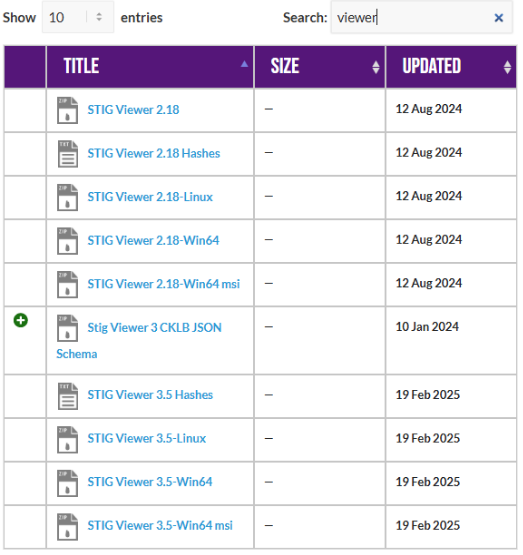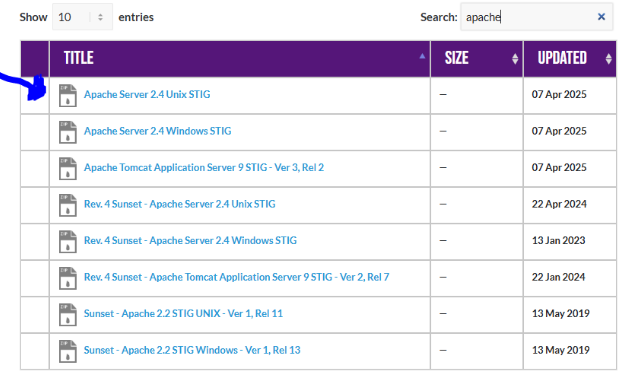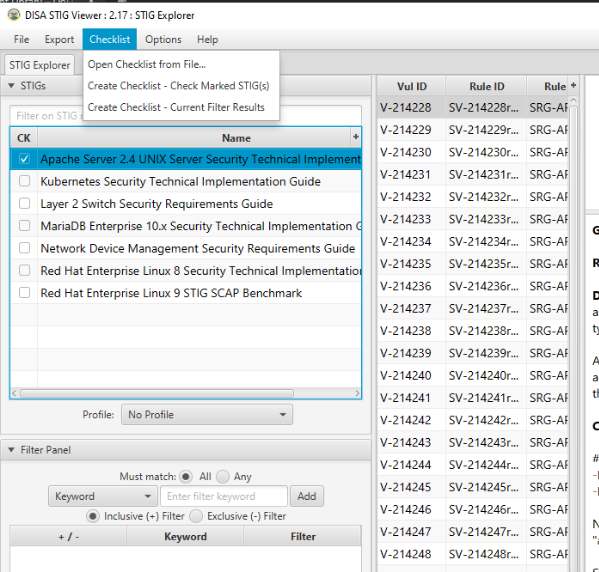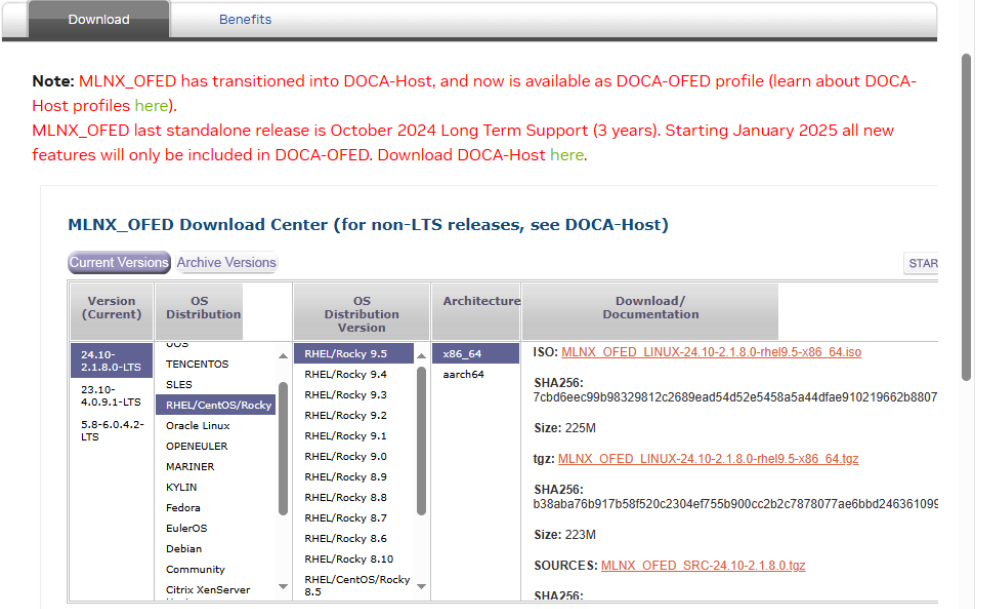If you are unable to finish the lab in the ProLUG lab environment we ask you
rebootthe machine from the command line so that other students will have the intended environment.
Required Materials
Putty or other connection tool Lab Server
Root or sudo command access
STIG Viewer 2.18 (download from https://public.cyber.mil/stigs/downloads/ )
Downloads
The lab has been provided below. The document(s) can be transposed to
the desired format so long as the content is preserved. For example, the .txt
could be transposed to a .md file.
PreLAB
Download the STIG Viewer 2.18 from - https://public.cyber.mil/stigs/downloads/

Download the STIG for Apache 2.4 and the import it into your STIG viewer

Create a checklist from the opened STIG for Apache 2.4

Review the software download process for Mellanox drivers:
Linux InfiniBand Drivers

Look through the available downloads and see if you can find the currently available
LTS for Rocky 9.5 x86_64.
After that find a distribution of your choice and play with their tool.
LAB
This lab is designed to have the engineer practice deploying patches in a Linux environment. The engineer will create repos and then deploy patches through an automated enterprise level Ansible playbook. But first, the engineer will review some of the Apache 2.4 STIG requirements if they want to run their own repo on their network.
Apache STIGs Review
-
Look at the 4 STIGs for "tls"
- What file is fixed for all of them to be remediated?
-
Install httpd on your Hammer server
systemctl stop wwclient dnf install -y httpd systemctl start httpd -
Check STIG V-214234
-
What is the problem?
-
What is the fix?
-
What type of control is being implemented?
-
Is it set properly on your system?
-
-
Check STIG V-214248
-
What is the problem?
-
What is the fix?
-
What type of control is being implemented?
-
Is it set properly on your system?
-
How do you think SELINUX will help implement this control in an enforcing state? Or will it not affect it?
-
Building repos
-
Start out by removing all your active repos
cd /etc/yum.repos.d mkdir old_archive mv *.repo old_archive dnf repolist -
Mount the local repository and make a local repo
mount -o loop /lab_work/repos_and_patching/Rocky-9.5-x86_64-dvd.iso /mnt df -h # Should see the mount point ls -l /mnt touch /etc/yum.repos.d/rocky9.repo vi /etc/yum.repos.d/rocky9.repoAdd the repo configuration:
[BaseOS] name=BaseOS Packages Rocky Linux 9 metadata_expire=-1 gpgcheck=1 enabled=1 baseurl=file:///mnt/BaseOS/ gpgkey=file:///etc/pki/rpm-gpg/RPM-GPG-KEY-redhat-release [AppStream] name=AppStream Packages Rocky Linux 9 metadata_expire=-1 gpgcheck=1 enabled=1 baseurl=file:///mnt/AppStream/ gpgkey=file:///etc/pki/rpm-gpg/RPM-GPG-KEY-redhat-releaseSave with
esc :wqor "shift + ZZ"- Do the paths you're using here make sense to you based off what you saw
when using the
ls -l? Why or why not?
chmod 644 /etc/yum.repos.d/rocky9.repo dnf clean all - Do the paths you're using here make sense to you based off what you saw
when using the
-
Test the local repository.
dnf repolist dnf --disablerepo="*" --enablerepo="AppStream" list available- Approximately how many are available?
dnf --disablerepo="*" --enablerepo="AppStream" list available | nl dnf --disablerepo="*" --enablerepo="AppStream" list available | nl | headNow use BaseOS.
dnf --disablerepo="*" --enablerepo="BaseOS" list available- Approximately how many are available?
dnf --disablerepo="*" --enablerepo="BaseOS" list available | nl dnf --disablerepo="*" --enablerepo="BaseOS" list available | nl | head-
Try to install something
dnf --disablerepo="*" --enablerepo="BaseOS AppStream" install gimp # hit "n"-
How many packages does it want to install?
-
How can you tell they're from different repos?
-
-
Share out the local repository for your internal systems (tested on just this one system)
rpm -qa | grep -i httpd systemctl status httpd ss -ntulp | grep 80 lsof -i :80 cd /etc/httpd/conf.d vi repos.confEdit the file:
<Directory "/mnt"> Options Indexes FollowSymLinks AllowOverride None Require all granted </Directory> Alias /repo /mnt <Location /repo> Options Indexes FollowSymLinks AllowOverride None Require all granted </Location>Restart the service.
systemctl restart httpd vi /etc/yum.repos.d/rocky9.repoEdit the file with your lab's name in the
baseurl:###USE YOUR HAMMER MACHINE IN BASEURL### [BaseOS] name=BaseOS Packages Rocky Linux 9 metadata_expire=-1 gpgcheck=1 enabled=1 #baseurl=file:///mnt/BaseOS/ baseurl=http://hammer25/repo/BaseOS/ gpgkey=file:///etc/pki/rpm-gpg/RPM-GPG-KEY-redhat-release [AppStream] name=AppStream Packages Rocky Linux 9 metadata_expire=-1 gpgcheck=1 enabled=1 #baseurl=file:///mnt/AppStream/ baseurl=http://hammer25/repo/AppStream/ gpgkey=file:///etc/pki/rpm-gpg/RPM-GPG-KEY-redhat-release- Do the paths you've modified at
baseurlmake sense to you? If not, what do you need to better understand?
dnf clean all dnf repolist Try to install something dnf --disablerepo="*" --enablerepo="BaseOS AppStream" install gimp - Do the paths you've modified at
Enterprise patching
-
Complete the killercoda lab found here: https://killercoda.com/het-tanis/course/Ansible-Labs/102-Enterprise-Ansible-Patching
- Look at the roles, in the order the are run in the playbook.
- Does it make sense how the custom facts are used? What other custom facts might you use?
- What are the prechecks doing? What other ones might you add?
- What does the reboot task do, and how does it check for reboot to be needed?
- Look at the roles, in the order the are run in the playbook.
Digging Deeper challenge (not required for finishing lab)
-
You've set up a local repository and you've shared that repo out to other systems that might want to connect. Why might you need this if you're going to fully air-gap systems?
Is it still necessary even if your enterprise patching solution is well designed? Why or why not? -
Can you add the Mellanox ISO that is included in the
/lab_work/repos_and_patchingsection to be a repository that your systems can access? If you have trouble, troubleshoot and ask the group for help. -
Make a pull request to improve the enterprise patching tool that you just used. Write up, for the group, why you need that change and how it improves the efficacy of the patching.
Be sure to
rebootthe lab machine from the command line when you are done.
